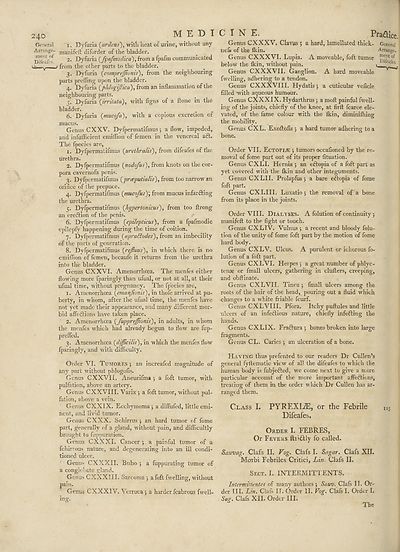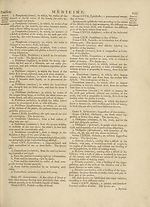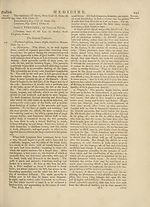Encyclopaedia Britannica, or, a Dictionary of arts, sciences, and miscellaneous literature : enlarged and improved. Illustrated with nearly six hundred engravings > Volume 13, MAT-MIC
(282) Page 240
Download files
Complete book:
Individual page:
Thumbnail gallery: Grid view | List view

240
General
Arrange¬
ment of
Difeafes.
MEDICINE.
1. Dyfuria ^aniens'), witli heat of urine, without any
manifeil cliforder of the bladder.
2. Dyfuria { fpafmodica), from a fpafm communicated
from the other parts to the bladder.
3. Dyfuria {comprejfionis'), from the neighbouring
parts preding upon the bladder.
4. Dyfuria {phlogiJHcct), from an inflammation of the
neighbouring parts.
j. Dyfuria {irritata), with figns of a Hone in the
bladder.
6. Dyfuria (niucofa), with a copious excretion of
mucus.
Gehus CXXV. Dyfpermatifmus} a flow, impeded,
and infufficient emiflion of femen in the venereal aft.
The fpecies are,
1. Dyfpermatifmus (iirethralls'), from difeafes of the
urethra.
2. Dyfpermatifmus (nodofus), from knots on the cor¬
pora cavernofa penis.
3. Dyfpermatifmus (prcvputialis), from too narrow an
orihce of the prepuce.
4. Dyfpermatifmus {mucofus), from mucus infarfting
the urethra.
5. Dyfpermatifmus {Jujpertonicus), from too flrong
an ereftion of the penis.
6. Dyfpermatifmus {epilepticus), from a fpafmodic
epilepfy happening during the time of coition.
7. Dyfpermatifmus {apraclodes), from an imbecility
of the parts of generation.
8. Dyfpermatifmus (rejluus), in which there is no
emiflion of femen, becaufe it returns from the urethra
into the bladder.
Genus CXXVI. Amenorrhoea. The menfes either
flowing more fparingly than ufual, or not at all, at their
ufuai time, without pregnancy. The fpecies are,
1. Amenorrhoea {emanfionis), in thofe arrived at pu¬
berty, in whom, after the ufual time, the menfes have
not yet made their appearance, and many different mor¬
bid affeftions have taken place.
2. Amenorrhoea {fupprejfionis), in adults, in whom
the menfes which had already begun to flow are fup-
preffed.
3. Amenorrhoea {dificilis), in which the menfes flow
fparingly, and with difficulty.
Order VI. Tumores *, an increafed magnitude of
any part without pblogofis.
Genus CXXVII. Aneurifma 5 a foft tumor, with
pulfation, above an artery.
Genus CXXVIII. Varix •, a foft tumor, without pul¬
fation, above a vein.
Genus CXX1X. Ecchymoma ; a dilfufed, little emi¬
nent, and livid tumor.
Genus CXXX. Schirrus j an hard tumor of fome
part, generally of a gland, without pain, and difficultly
brought to fuppuration.
Genus CXXXI. Cancer ; a painful tumor of a
fchirrous nature, and degenerating into an ill condi¬
tioned ulcer.
Genus CXXXII. Bubo 5 a fuppurating tumor of
a conglobate gland.
Genus CXXXIII. Sarcoma ; a foft fwelling, without
pain.
Genus CXXXIV. Verruca j a harder fcabrous fwell-
ing.
Pra&ice.
Genus CXXXV. Clavus ; a hard, lamellated thick- Gcnoral
neft* of the fkin. Arrange.
Genus CXXXVI. Lupia. A moveable, foft tumor ™!pitof
below the fkin, without pain. 1 '1‘^“,csj
Genus CXXXVII. Ganglion. A hard moveable
fwelling, adhering to a tendon.
Genus CXXXVIII. Hydatis $ a cuticular veficle
filled ’with aqueous humour.
Genus CXXXIX. Hydarthrus} a mofi: painful fwell¬
ing of the joints, chiefly of the knee, at firft fcarce ele¬
vated, of the fame colour with the fkin, diminiffiing
the mobility.
Genus CXL. Exoflofis 5 a hard tumor adhering to a
bone.
Order VII. Ectopia: ; tumors occafioned by the re¬
moval of fome part out of its proper fituation.
Genus CXLI. Hernia j an eftopia of a foft part as
yet covered with the fkin and other integuments.
Genus CXLII. Prolapfus 5 a bare eftopia of fome
foft part.
Genus CXLIII. Luxatio 5 the removal of a bone
from its place in the joints.
Order VIII. Dialyses. A folution of continuity j
manifeft to the fight or touch.
Genus CXLlV. Vulnus 5 a recent and bloody folu¬
tion of the unity of fome foft part by the motion of fome
hard body.
Genus CXLV. Ulcus. A purulent or ichorous fo¬
lution of a foft part.
Genus CXLVI. Herpes ; a great number of phlyc-
tenae or fmall ulcers, gathering in clufters, creeping,
and obflinate.
Genus CXLVII. Tinea j fmall ulcers among the
roots of the hair of the head, pouring out a fluid which
-changes to a white friable feurf.
Genus CXLVIII. Pfora. Itchy puftules and little
ulcers of an infeftious nature, chiefly infefting the
hands.
Genus CXLIX. Fraftura ; bones broken into large
fragments.
Genus CL. Caries j an ulceration of a bone.
Having thus prefented to our readers Dr Cullen’s
general fyllematic view of all the difeafes to which the
human body is fubjefted, v7e come next to give a more
particular account of the more important affeftions,
treating of them in the order which Dr Cullen has ar¬
ranged them.
Class I. PYREXIiE, or the Febrile ns
Difeales.
Order I. FEBRES,
Or Fevers ftii£Uy fo called.
Sauvag. Clafs II. Vog. Clafs I. Sagar. Clafs XII.
Morbi Febriles Critici, Lin. Clafs II.
Sect. I. INTERM ITT ENTS.
Intermittentes of many authors j Sauv. Clafs II. Or¬
der III. Lin. Clafs If. Order II. Vog. Clafs I. Older I.
Sag. Clafs XII. Order III.
The
General
Arrange¬
ment of
Difeafes.
MEDICINE.
1. Dyfuria ^aniens'), witli heat of urine, without any
manifeil cliforder of the bladder.
2. Dyfuria { fpafmodica), from a fpafm communicated
from the other parts to the bladder.
3. Dyfuria {comprejfionis'), from the neighbouring
parts preding upon the bladder.
4. Dyfuria {phlogiJHcct), from an inflammation of the
neighbouring parts.
j. Dyfuria {irritata), with figns of a Hone in the
bladder.
6. Dyfuria (niucofa), with a copious excretion of
mucus.
Gehus CXXV. Dyfpermatifmus} a flow, impeded,
and infufficient emiflion of femen in the venereal aft.
The fpecies are,
1. Dyfpermatifmus (iirethralls'), from difeafes of the
urethra.
2. Dyfpermatifmus (nodofus), from knots on the cor¬
pora cavernofa penis.
3. Dyfpermatifmus (prcvputialis), from too narrow an
orihce of the prepuce.
4. Dyfpermatifmus {mucofus), from mucus infarfting
the urethra.
5. Dyfpermatifmus {Jujpertonicus), from too flrong
an ereftion of the penis.
6. Dyfpermatifmus {epilepticus), from a fpafmodic
epilepfy happening during the time of coition.
7. Dyfpermatifmus {apraclodes), from an imbecility
of the parts of generation.
8. Dyfpermatifmus (rejluus), in which there is no
emiflion of femen, becaufe it returns from the urethra
into the bladder.
Genus CXXVI. Amenorrhoea. The menfes either
flowing more fparingly than ufual, or not at all, at their
ufuai time, without pregnancy. The fpecies are,
1. Amenorrhoea {emanfionis), in thofe arrived at pu¬
berty, in whom, after the ufual time, the menfes have
not yet made their appearance, and many different mor¬
bid affeftions have taken place.
2. Amenorrhoea {fupprejfionis), in adults, in whom
the menfes which had already begun to flow are fup-
preffed.
3. Amenorrhoea {dificilis), in which the menfes flow
fparingly, and with difficulty.
Order VI. Tumores *, an increafed magnitude of
any part without pblogofis.
Genus CXXVII. Aneurifma 5 a foft tumor, with
pulfation, above an artery.
Genus CXXVIII. Varix •, a foft tumor, without pul¬
fation, above a vein.
Genus CXX1X. Ecchymoma ; a dilfufed, little emi¬
nent, and livid tumor.
Genus CXXX. Schirrus j an hard tumor of fome
part, generally of a gland, without pain, and difficultly
brought to fuppuration.
Genus CXXXI. Cancer ; a painful tumor of a
fchirrous nature, and degenerating into an ill condi¬
tioned ulcer.
Genus CXXXII. Bubo 5 a fuppurating tumor of
a conglobate gland.
Genus CXXXIII. Sarcoma ; a foft fwelling, without
pain.
Genus CXXXIV. Verruca j a harder fcabrous fwell-
ing.
Pra&ice.
Genus CXXXV. Clavus ; a hard, lamellated thick- Gcnoral
neft* of the fkin. Arrange.
Genus CXXXVI. Lupia. A moveable, foft tumor ™!pitof
below the fkin, without pain. 1 '1‘^“,csj
Genus CXXXVII. Ganglion. A hard moveable
fwelling, adhering to a tendon.
Genus CXXXVIII. Hydatis $ a cuticular veficle
filled ’with aqueous humour.
Genus CXXXIX. Hydarthrus} a mofi: painful fwell¬
ing of the joints, chiefly of the knee, at firft fcarce ele¬
vated, of the fame colour with the fkin, diminiffiing
the mobility.
Genus CXL. Exoflofis 5 a hard tumor adhering to a
bone.
Order VII. Ectopia: ; tumors occafioned by the re¬
moval of fome part out of its proper fituation.
Genus CXLI. Hernia j an eftopia of a foft part as
yet covered with the fkin and other integuments.
Genus CXLII. Prolapfus 5 a bare eftopia of fome
foft part.
Genus CXLIII. Luxatio 5 the removal of a bone
from its place in the joints.
Order VIII. Dialyses. A folution of continuity j
manifeft to the fight or touch.
Genus CXLlV. Vulnus 5 a recent and bloody folu¬
tion of the unity of fome foft part by the motion of fome
hard body.
Genus CXLV. Ulcus. A purulent or ichorous fo¬
lution of a foft part.
Genus CXLVI. Herpes ; a great number of phlyc-
tenae or fmall ulcers, gathering in clufters, creeping,
and obflinate.
Genus CXLVII. Tinea j fmall ulcers among the
roots of the hair of the head, pouring out a fluid which
-changes to a white friable feurf.
Genus CXLVIII. Pfora. Itchy puftules and little
ulcers of an infeftious nature, chiefly infefting the
hands.
Genus CXLIX. Fraftura ; bones broken into large
fragments.
Genus CL. Caries j an ulceration of a bone.
Having thus prefented to our readers Dr Cullen’s
general fyllematic view of all the difeafes to which the
human body is fubjefted, v7e come next to give a more
particular account of the more important affeftions,
treating of them in the order which Dr Cullen has ar¬
ranged them.
Class I. PYREXIiE, or the Febrile ns
Difeales.
Order I. FEBRES,
Or Fevers ftii£Uy fo called.
Sauvag. Clafs II. Vog. Clafs I. Sagar. Clafs XII.
Morbi Febriles Critici, Lin. Clafs II.
Sect. I. INTERM ITT ENTS.
Intermittentes of many authors j Sauv. Clafs II. Or¬
der III. Lin. Clafs If. Order II. Vog. Clafs I. Older I.
Sag. Clafs XII. Order III.
The
Set display mode to:
![]() Universal Viewer |
Universal Viewer | ![]() Mirador |
Large image | Transcription
Mirador |
Large image | Transcription
Images and transcriptions on this page, including medium image downloads, may be used under the Creative Commons Attribution 4.0 International Licence unless otherwise stated. ![]()
| Permanent URL | https://digital.nls.uk/192664828 |
|---|
| Attribution and copyright: |
|
|---|
| Description | Ten editions of 'Encyclopaedia Britannica', issued from 1768-1903, in 231 volumes. Originally issued in 100 weekly parts (3 volumes) between 1768 and 1771 by publishers: Colin Macfarquhar and Andrew Bell (Edinburgh); editor: William Smellie: engraver: Andrew Bell. Expanded editions in the 19th century featured more volumes and contributions from leading experts in their fields. Managed and published in Edinburgh up to the 9th edition (25 volumes, from 1875-1889); the 10th edition (1902-1903) re-issued the 9th edition, with 11 supplementary volumes. |
|---|---|
| Additional NLS resources: |
|

